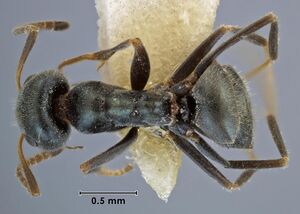Iridomyrmex cupreus
| Iridomyrmex cupreus | |
|---|---|

| |
| Scientific classification | |
| Kingdom: | Animalia |
| Phylum: | Arthropoda |
| Class: | Insecta |
| Order: | Hymenoptera |
| Family: | Formicidae |
| Subfamily: | Dolichoderinae |
| Tribe: | Leptomyrmecini |
| Genus: | Iridomyrmex |
| Species: | I. cupreus |
| Binomial name | |
| Iridomyrmex cupreus Heterick & Shattuck, 2011 | |
Only a handful of pins of this very uncommon ant only are known, all collections having been made in the vicinity of Lake Eyre, South Australia.
Identification
This is yet another rather physically undistinguished ant. The small-medium workers can mainly be distinguished from species like Iridomyrmex splendens, Iridomyrmex mjobergi and Iridomyrmex coeruleus by the presence of erect setae on the tibiae, the latter species having glabrous tibiae (all in all, I. cupreus is a rather hairy ant, but the erect setae are short, thus distinguishing this species from I. spurcus). The eye is slightly asymmetrical, and reminiscent of many workers of Iridomyrmex dromus.
Keys including this Species
Distribution
Latitudinal Distribution Pattern
Latitudinal Range: -28.91666667° to -29.764377°.
| North Temperate |
North Subtropical |
Tropical | South Subtropical |
South Temperate |
- Source: AntMaps
Distribution based on Regional Taxon Lists
Australasian Region: Australia (type locality).
Distribution based on AntMaps
Distribution based on AntWeb specimens
Check data from AntWeb
Countries Occupied
| Number of countries occupied by this species based on AntWiki Regional Taxon Lists. In general, fewer countries occupied indicates a narrower range, while more countries indicates a more widespread species. |

|
Estimated Abundance
| Relative abundance based on number of AntMaps records per species (this species within the purple bar). Fewer records (to the left) indicates a less abundant/encountered species while more records (to the right) indicates more abundant/encountered species. |

|
Biology
Castes
Worker
  
| |
| . | |
Nomenclature
The following information is derived from Barry Bolton's Online Catalogue of the Ants of the World.
- cupreus. Iridomyrmex cupreus Heterick & Shattuck, 2011: 69, figs. 28, 91 (w.) AUSTRALIA.
Type Material
- Holotype, worker, Blanche Cup Spring, near Coward Spring, South Australia, Australia, 18 August 1977, ANIC32-037093, Australian National Insect Collection; edge of swamp.
- Paratype, 3 workers, William Creek, South Australia, Australia, 23 July 1956, R. S. McInnes, ANIC32-040968, Australian National Insect Collection.
- Paratype, 3 workers, William Creek, South Australia, Australia, 23 July 1956, R. S. McInnes, ANIC32-040947, Museum of Comparative Zoology.
Description
Worker Description. Head. Posterior margin of head weakly concave; erect setae on posterior margin in full- face view set in a row; sides of head noticeably convex; erect genal setae present on sides of head in full-face view. Ocelli absent; in full-face view, eyes set below midpoint of head capsule; in profile, eye set anteriad of head capsule; eye asymmetrical, curvature of inner eye margin more pronounced than its outer margin and anterior sector of eye distinctly broader than its posterior sector. Frontal carinae convex; antennal scape surpassing posterior margin of head by 1-2 x its diameter. Erect setae on scape absent, except at tip; prominence on anteromedial clypeal margin projecting as blunt but distinct protuberance; mandible elongate triangular with oblique basal margin; long, curved setae on venter of head capsule absent. Mesosoma. Pronotum moderately and evenly curved over its length. Erect pronotal setae numerous (12 or more) and longest setae elongate, flexuous and/or curved, or numerous (12 or more), short and bristly. Mesonotum sinuous, or straight. Erect mesonotal setae moderate in number (6-12), short and bristly. Mesothoracic spiracles always inconspicuous; propodeal dorsum smoothly and evenly convex; placement of propodeal spiracle posteriad and near propodeal declivity; propodeal angle weakly present or absent, the confluence of the dorsal and declivitous propodeal faces indicated, if at all, by an undulation. Erect propodeal setae moderate in number (6-12), short and bristly. Petiole. Dorsum of node convex; node thin, scale-like, orientation more-or-less vertical. Gaster. Non-marginal erect setae of gaster present on first gastral tergite; marginal erect setae of gaster present on first tergite. General characters. Allometric differences between workers of same nest absent. Colour uniformly dark chocolate, with dull coppery to bluish reflections. Colour of erect setae whitish.
Measurements. Worker (n = 2)—CI 86–88; EI 29–30; EL 0.20–0.21; EW 0.16–0.16; HFL 0.85–0.89; HL 0.80–0.83; HW 0.69–0.74; ML 0.97–1.01; MTL 0.60–0.65; PpH 0.11–0.14; PpL 0.41–0.42; SI 97–102; SL 0.70– 0.72.
Etymology
Latin: the name refers to the coppery appearance of the worker cuticle. Weak bluish reflections may also be seen in a few workers.

